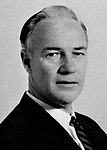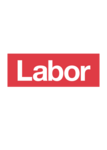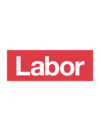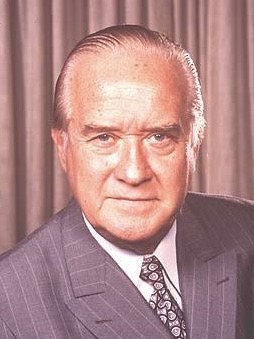
Sir Robert William Askin, GCMG, was an Australian politician and the 32nd premier of New South Wales from 1965 to 1975, the first representing the Liberal Party. He was born in 1907 as Robin William Askin, but always disliked his first name and changed it by deed poll in 1971. Before being knighted in 1972, however, he was generally known as Bob Askin. Born in Sydney in 1907, Askin was educated at Sydney Technical High School. After serving as a bank officer and as a sergeant in the Second World War, Askin joined the Liberal Party and was elected to the seat of Collaroy at the 1950 election.

John Thomas Lang, nicknamed "The Big Fella", was an Australian politician. He served two terms as premier of New South Wales, in office from 1925 to 1927 and from 1930 to 1932. He was the state leader of the Australian Labor Party (ALP) from 1923 to 1939 and his Lang Labor faction was an influential force in both state and federal politics, breaking away from the official ALP on several occasions.
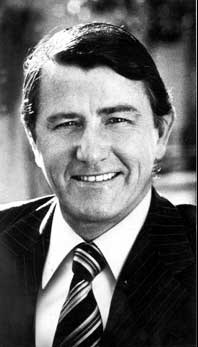
Neville Kenneth Wran, was an Australian politician who was the Premier of New South Wales from 1976 to 1986. He was the national president of the Australian Labor Party (ALP) from 1980 to 1986 and chairman of both the Lionel Murphy Foundation and the Commonwealth Scientific and Industrial Research Organisation (CSIRO) from 1986 to 1991.

Sir Eric Archibald Willis was an Australian politician, Cabinet Minister and the 34th Premier of New South Wales, serving from 23 January 1976 to 14 May 1976. Born in Murwillumbah in 1922, Willis was educated at Murwillumbah High School and the University of Sydney, where he obtained a Bachelor of Arts with double honours. Enlisting during World War II, Willis served on the homefront and later served in New Guinea and the Philippines. He continued to serve the Citizen Military Forces until 1958.
The following lists events that happened during 1983 in Australia.

Robert James Heffron, also known as Bob Heffron or R. J. Heffron, was a long-serving New South Wales politician, union organiser and Labor Party Premier of New South Wales from 1959 to 1964. Born in New Zealand, Heffron became involved in various Socialist and labour movements in New Zealand and later Australia before joining the Australian Labor Party. A prominent unionist organiser, he was gaoled for "conspiracy to strike action". He was later elected to the Parliament of New South Wales for Botany in 1930. However his disputes with party leader Jack Lang led to his expulsion from the ALP in 1936 and Heffron formed his own party from disgruntled Labor MPs known as the Industrial Labor Party. The success of his party enabled his readmission to the party and his prominence in a post-Lang NSW Branch which won office in 1941.

John Joseph Gregory McGirr was an Australian politician who served in the New South Wales Legislative Assembly from 1913 to 1925, representing the Labor Party. He served as the party's leader for little over a month in 1923, during an internal dispute. He had earlier served as deputy leader and as Minister for Public Health under James Dooley.

Kenneth George Booth was a New South Wales politician, Treasurer, and Minister of the Crown in the cabinets of Neville Wran and Barrie Unsworth. From 1981 to 1988 he was the Treasurer of New South Wales. He was a member of the New South Wales Legislative Assembly for 28 years from 8 October 1960 until his death on 1 November 1988 for the Labor Party, representing the seats of Kurri Kurri and Wallsend.

The New South Wales Labor Party, officially known as the Australian Labor Party and commonly referred to simply as NSW Labor, is the New South Wales branch of the Australian Labor Party (ALP). The branch is the current ruling party in the state of New South Wales and is led by Chris Minns, who has served concurrently as premier of New South Wales since 2023.
Members of the New South Wales Legislative Council between 1973 and 1976 were indirectly elected by a joint sitting of the New South Wales Parliament, with 15 members elected every three years. The most recent election was on 5 April 1973, with the term of new members commencing on 23 April 1973. The President was Sir Harry Budd.

The Wran ministry (1976–1978) or First Wran ministry was the 71st ministry of the New South Wales Government, and was led by the 35th Premier of New South Wales, Neville Wran, representing the Labor Party. It was the first of eight consecutive occasions when Wran was Premier.

The Wran ministry (1978–1980) or Second Wran ministry was the 72nd ministry of the New South Wales Government, and was led by the 35th Premier of New South Wales, Neville Wran, representing the Labor Party. It was the second of eight consecutive occasions when Wran was Premier.

The Wran ministry (1980–1981) or Third Wran ministry was the 73rd ministry of the New South Wales Government, and was led by the 35th Premier of New South Wales, Neville Wran, representing the Labor Party. It was the third of eight consecutive occasions when Wran was Premier.

The Wran ministry (1981–1983) or Fourth Wran ministry was the 74th ministry of the New South Wales Government, and was led by the 35th Premier of New South Wales, Neville Wran, representing the Labor Party. It was the fourth of eight consecutive occasions when Wran was Premier.

The Wran ministry (1983–1984) or Fifth Wran ministry was the 75th ministry of the New South Wales Government, and was led by the 35th Premier of New South Wales, Neville Wran, representing the Labor Party. It was the fifth of eight consecutive occasions when Wran was Premier.

The Wran ministry (1984) or Sixth Wran ministry was the 76th ministry of the New South Wales Government, and was led by the 35th Premier of New South Wales, Neville Wran, representing the Labor Party. It was the sixth of eight consecutive occasions when Wran was Premier.

The Wran ministry (1984–1986) or Seventh Wran ministry was the 77th ministry of the New South Wales Government, and was led by the 35th Premier of New South Wales, Neville Wran, representing the Labor Party. It was the seventh of eight consecutive occasions when Wran was Premier.

The Wran ministry (1986) or Eighth Wran ministry was the 78th ministry of the New South Wales Government, and was led by the 35th Premier of New South Wales, Neville Wran, representing the Labor Party. It was the eighth of eight consecutive and final occasions when Wran was Premier.
A referendum concerning the reform of the New South Wales Legislative Council was put to New South Wales voters on 13 May 1933 and was passed by the voters with a margin of 2.94%. The text of the question was:
Do you approve of the Bill entitled "A Bill to reform the constitution and alter the Powers of the Legislative Council; to reduce and limit the number of Members of the Legislative Council; to reconstitute the Legislative Council in accordance with the reformed constitution; to amend the Constitution Act, 1902, and certain other Acts; and for purposes connected therewith."

